In recent years, epoxy resin has taken the world of interior design by storm, adding a unique aesthetic to various home elements, from countertops to tables. One of the most striking applications of epoxy in modern homes is the epoxy river staircase, which transforms traditional steps into a mesmerizing visual journey. An epoxy river staircase incorporates translucent or colored resin within natural wood, creating the illusion of a flowing river through the staircase. This piece will explore what epoxy river staircases are, how they’re made, why they’re so appealing, and how you can incorporate this unique feature into your own home.
Contents
- 1 1. What is an Epoxy River Staircase?
- 2 2. Key Elements and Construction of an Epoxy River Staircase
- 3 3. Why Choose an Epoxy River Staircase?
- 4 4. Designing an Epoxy River Staircase: Considerations for Your Home
- 5 5. Maintenance and Care Tips for Epoxy River Staircases
- 6 6. Where to Use Epoxy River Staircases
- 7 7. Unique Variations and Ideas for Epoxy River Staircases
- 8 8. Installation and Cost Considerations
- 9 9. Epoxy River Staircases as an Expression of Style and Personality
- 10 Conclusion: Embracing the Art and Innovation of Epoxy River Staircases
1. What is an Epoxy River Staircase?
A. Definition and Concept
An epoxy river staircase is a staircase that integrates epoxy resin with wood to mimic the appearance of a river flowing between or across each step. By pouring epoxy resin, often tinted in blue or turquoise hues, into a carved-out section of wood, designers create a visually stunning effect that resembles a river winding through nature.
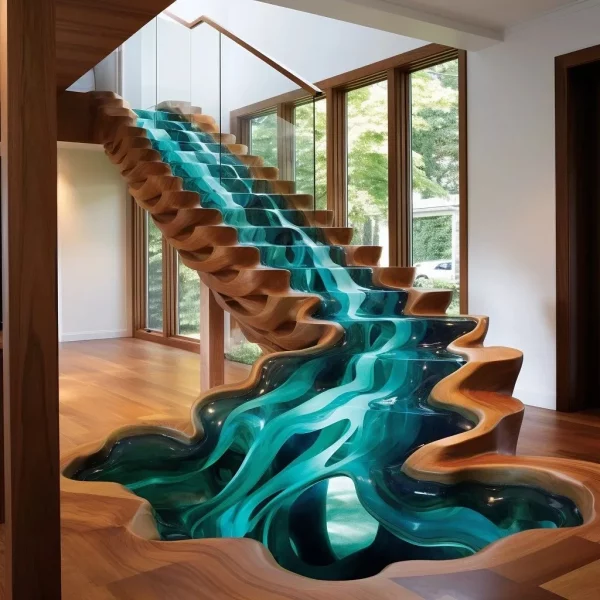
B. Inspiration Behind the Design
The concept of epoxy rivers in furniture design originated with epoxy river tables, where designers used resin to simulate water flowing within the table. This artistic approach quickly gained popularity, evolving into staircases, countertops, and other elements, merging art with everyday functionality.
C. Differentiating Features
Epoxy river staircases differ from traditional staircases due to their unique, nature-inspired aesthetic, which adds a dramatic touch to home interiors. Unlike conventional materials, epoxy provides an endless variety of color and style options that can be customized to fit any home decor.
2. Key Elements and Construction of an Epoxy River Staircase
A. The Use of Natural Wood
The natural wood used in epoxy river staircases, such as walnut, oak, or maple, adds warmth and complements the vibrant resin, creating a harmonious balance. Designers often use live-edge wood to enhance the natural, organic feel of the staircase.
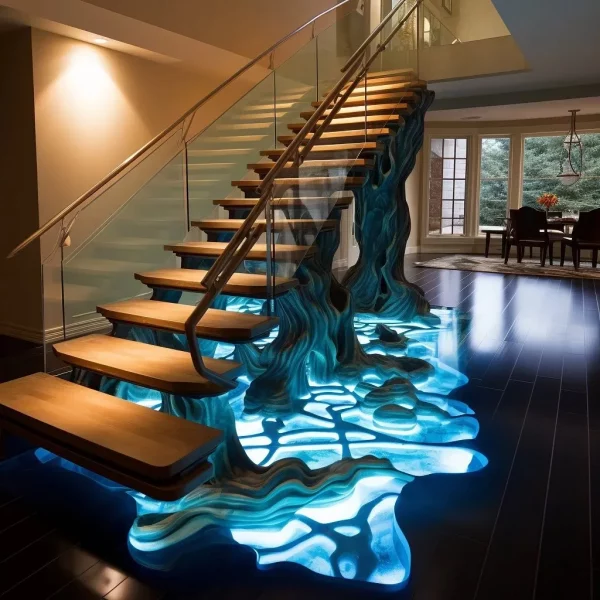
B. High-Quality Epoxy Resin
Epoxy resin is chosen for its durability, strength, and clarity, which allows for a deep, glass-like finish. High-quality, UV-resistant epoxy is typically used to prevent yellowing and to ensure the staircase retains its stunning appearance over time.
C. Craftsmanship and Design Process
Crafting an epoxy river staircase requires a skilled artisan who can meticulously carve, pour, and polish each step. The process involves carving channels into the wood, carefully pouring and coloring the resin, and multiple rounds of sanding and finishing to achieve a flawless, river-like effect.
3. Why Choose an Epoxy River Staircase?
A. Adding a Unique Artistic Touch to the Home
An epoxy river staircase is not only functional but also serves as a piece of art. Its design transforms an otherwise ordinary staircase into a visually captivating element that can become the focal point of the home.
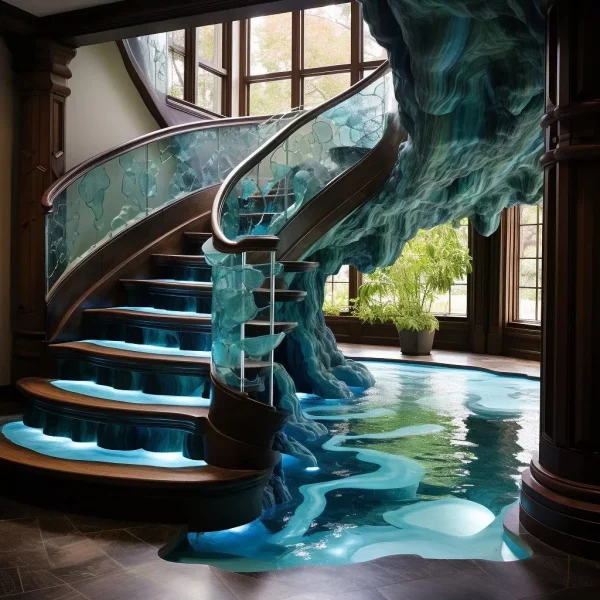
B. Customization Options
One of the biggest appeals of epoxy river staircases is their flexibility in design. Homeowners can choose from various resin colors, wood types, and even embedded elements like stones or shells, allowing them to customize the staircase to match their unique style.
C. Durability and Longevity
Epoxy is highly durable, water-resistant, and scratch-resistant, making it an excellent choice for a staircase that will endure daily foot traffic. With proper maintenance, an epoxy river staircase can last for many years while maintaining its beautiful appearance.
D. Eco-Friendly Appeal
The use of natural wood and epoxy in staircases appeals to eco-conscious homeowners who appreciate sustainable materials. Many artisans select responsibly sourced or reclaimed wood, adding an environmentally friendly element to the design.
4. Designing an Epoxy River Staircase: Considerations for Your Home
A. Choosing the Right Resin Color and Transparency
The color of the epoxy resin plays a critical role in achieving the desired look. Many people opt for blue or turquoise hues to mimic water, but other colors, such as green or even black, can create unique visual effects that align with different aesthetics.

B. Selecting the Type of Wood
The type of wood used for the staircase will influence its overall aesthetic. Walnut, with its dark tones, creates a rich, luxurious look, while lighter woods like oak or maple offer a more natural, rustic appearance.
C. Matching the Home’s Interior Style
When choosing an epoxy river staircase, it’s essential to consider the home’s existing design style. An epoxy river staircase can blend seamlessly into rustic, modern, or industrial interiors, provided it’s designed to complement the surrounding decor.
D. Lighting Enhancements
Adding LED lighting to an epoxy river staircase enhances its appeal, making the “river” appear to glow at night. This lighting effect adds depth to the staircase, further emphasizing the resin’s clarity and the wood’s texture.
5. Maintenance and Care Tips for Epoxy River Staircases
A. Regular Cleaning
Epoxy river staircases are easy to clean and maintain, requiring only a soft cloth and mild soap. Avoid abrasive cleaners that could scratch the resin’s surface.
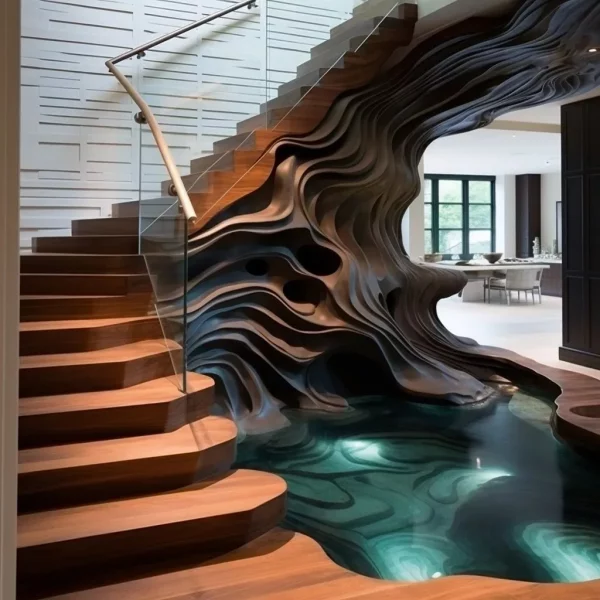
B. Avoiding Direct Sunlight
Prolonged exposure to direct sunlight can cause epoxy resin to yellow over time. It’s recommended to install UV-protective windows or apply a UV-protective coating to prevent this.
C. Polishing the Resin Surface
Regular polishing can help maintain the epoxy’s glossy finish. Using a resin-specific polish can enhance clarity and keep the river effect looking vibrant.
D. Repairing Minor Scratches
Minor scratches on the resin surface can be repaired using fine-grit sandpaper and resin polish. For significant damage, consult a professional to avoid further harm to the staircase.
6. Where to Use Epoxy River Staircases
A. Private Homes
Epoxy river staircases are especially popular in private homes, where they can serve as the main staircase or as a secondary staircase in a unique or themed room.
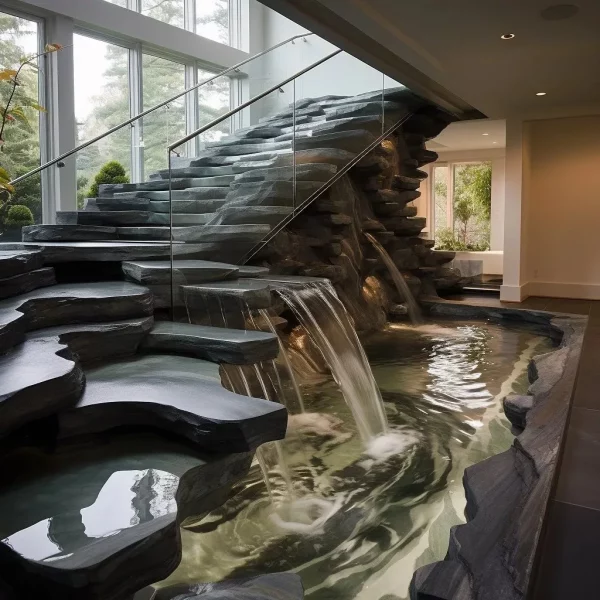
B. Hotels and Resorts
Boutique hotels and resorts looking to offer a memorable experience to guests can incorporate epoxy river staircases in lobbies or suites, creating a luxurious and artistic environment.
C. Commercial Spaces
Art galleries, high-end restaurants, and retail stores can use epoxy river staircases to enhance their ambiance and provide a focal point that attracts attention and complements a modern aesthetic.
D. Showrooms
For furniture or design showrooms, an epoxy river staircase can serve as a beautiful showcase of innovative design, drawing in customers and demonstrating the potential of epoxy resin in interior spaces.
7. Unique Variations and Ideas for Epoxy River Staircases
A. Embedded Objects and Natural Elements
Some designers embed small stones, shells, or even miniature plants within the resin to create a natural, riverbed-like effect. These added elements make the staircase feel even more immersive and artistic.
B. Layered Epoxy Colors
For a multi-dimensional look, artisans may use different layers of colored epoxy, creating depth and giving the impression of a deeper river. This technique enhances the river effect and adds complexity to the design.
C. Color-Changing Epoxy
Using color-changing or glow-in-the-dark epoxy offers a futuristic twist, creating an interactive staircase that changes appearance based on the time of day or lighting conditions.
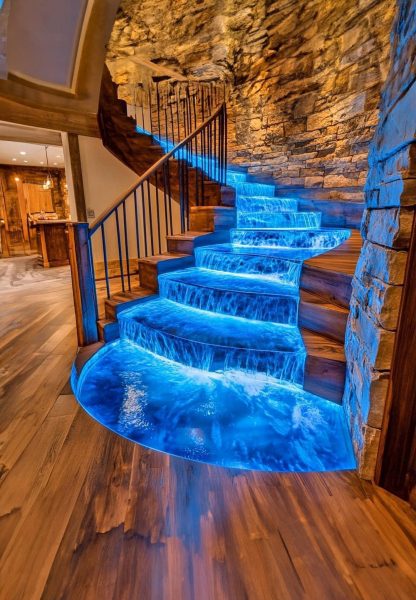
D. Combining Metal and Epoxy
Incorporating metal accents, such as steel railings or metal inlays within the epoxy, adds an industrial edge that can contrast beautifully with the natural wood and resin.
8. Installation and Cost Considerations
A. Hiring Skilled Artisans
Due to the intricate work involved, it’s best to hire an experienced artisan or craftsman specializing in epoxy and woodwork for the installation of an epoxy river staircase.
B. Price Factors
The cost of an epoxy river staircase varies depending on the type of wood, quality of epoxy, and level of customization. Additional features, like embedded elements or lighting, can further impact the price.
C. Installation Time
Creating and installing an epoxy river staircase is a time-intensive process, with some projects taking several weeks to complete. Planning ahead is essential to ensure timely completion.
9. Epoxy River Staircases as an Expression of Style and Personality
A. A Personal Artistic Statement
An epoxy river staircase is more than just a functional feature; it’s a personal expression of style. Each design is unique, reflecting the owner’s tastes and personality.
B. The Future of Epoxy Design
The popularity of epoxy river furniture suggests that epoxy river staircases are here to stay, with new design innovations continuously emerging. The versatility of epoxy allows for endless customization, ensuring that this trend will evolve with time.
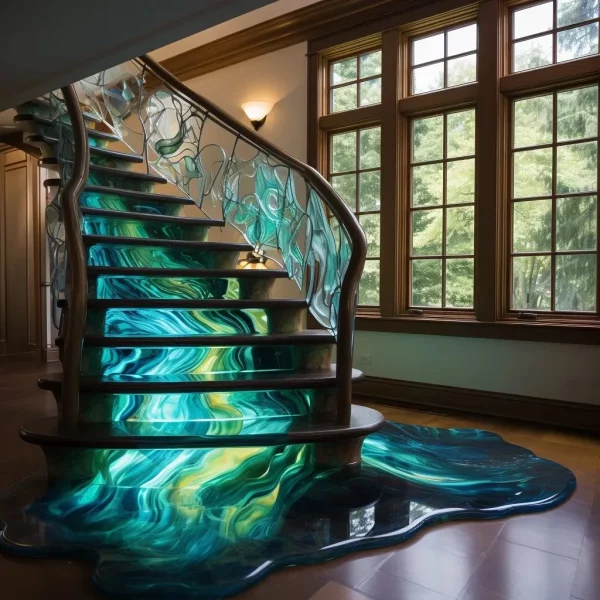
C. Blending with Nature
With their organic shapes and natural materials, epoxy river staircases resonate with homeowners seeking a closer connection to nature within their living spaces.
Conclusion: Embracing the Art and Innovation of Epoxy River Staircases
An epoxy river staircase is a unique blend of art and functionality that turns an everyday architectural feature into a captivating centerpiece. With its customizable design, natural elements, and creative use of materials, this type of staircase stands as a testament to innovation in interior design. Whether it’s in a private residence or a commercial space, an epoxy river staircase adds a touch of nature-inspired beauty, elevating the aesthetic of any setting. For those looking to make a bold, artistic statement, the epoxy river staircase offers an unforgettable way to redefine the look and feel of their home.






